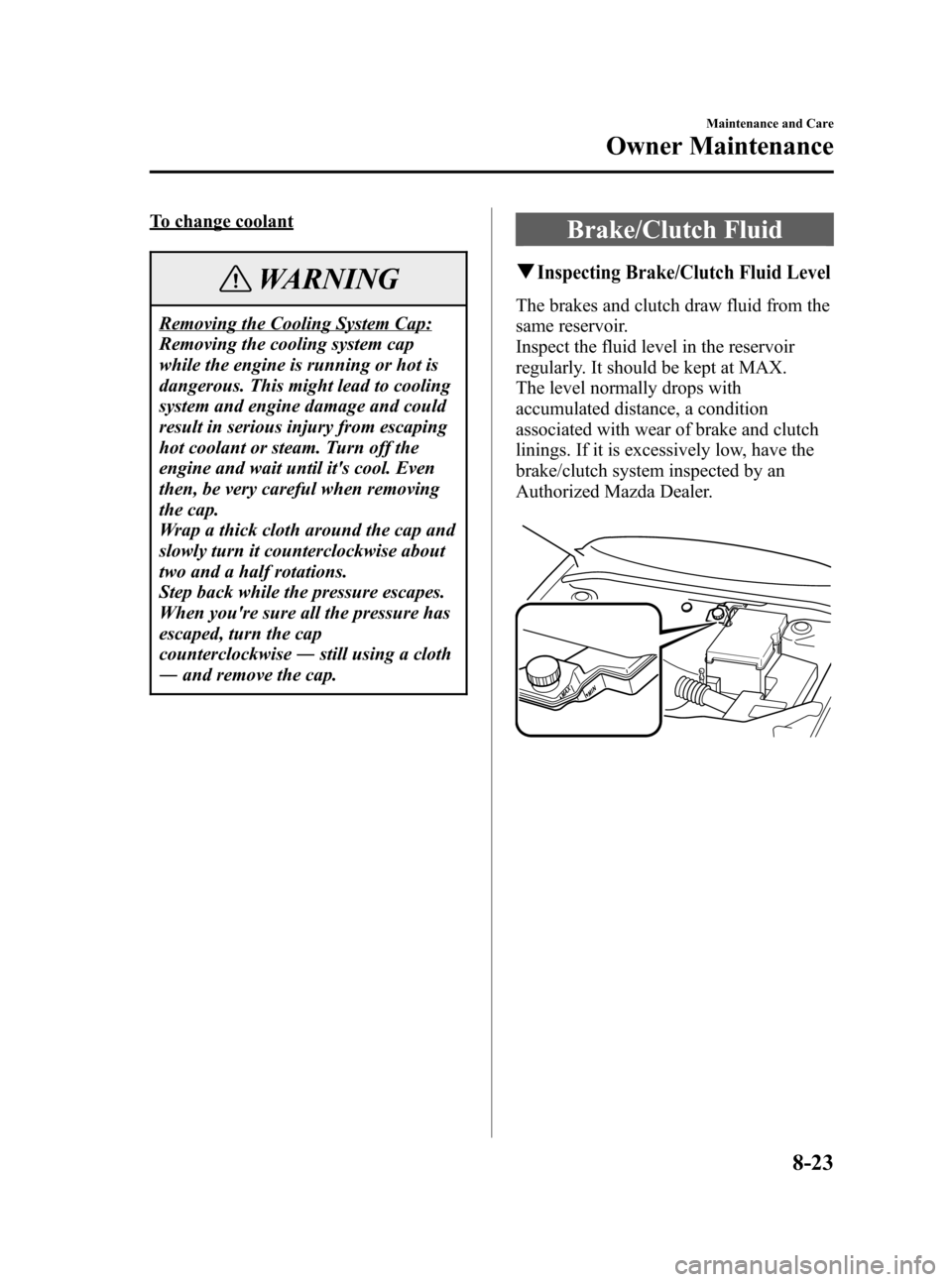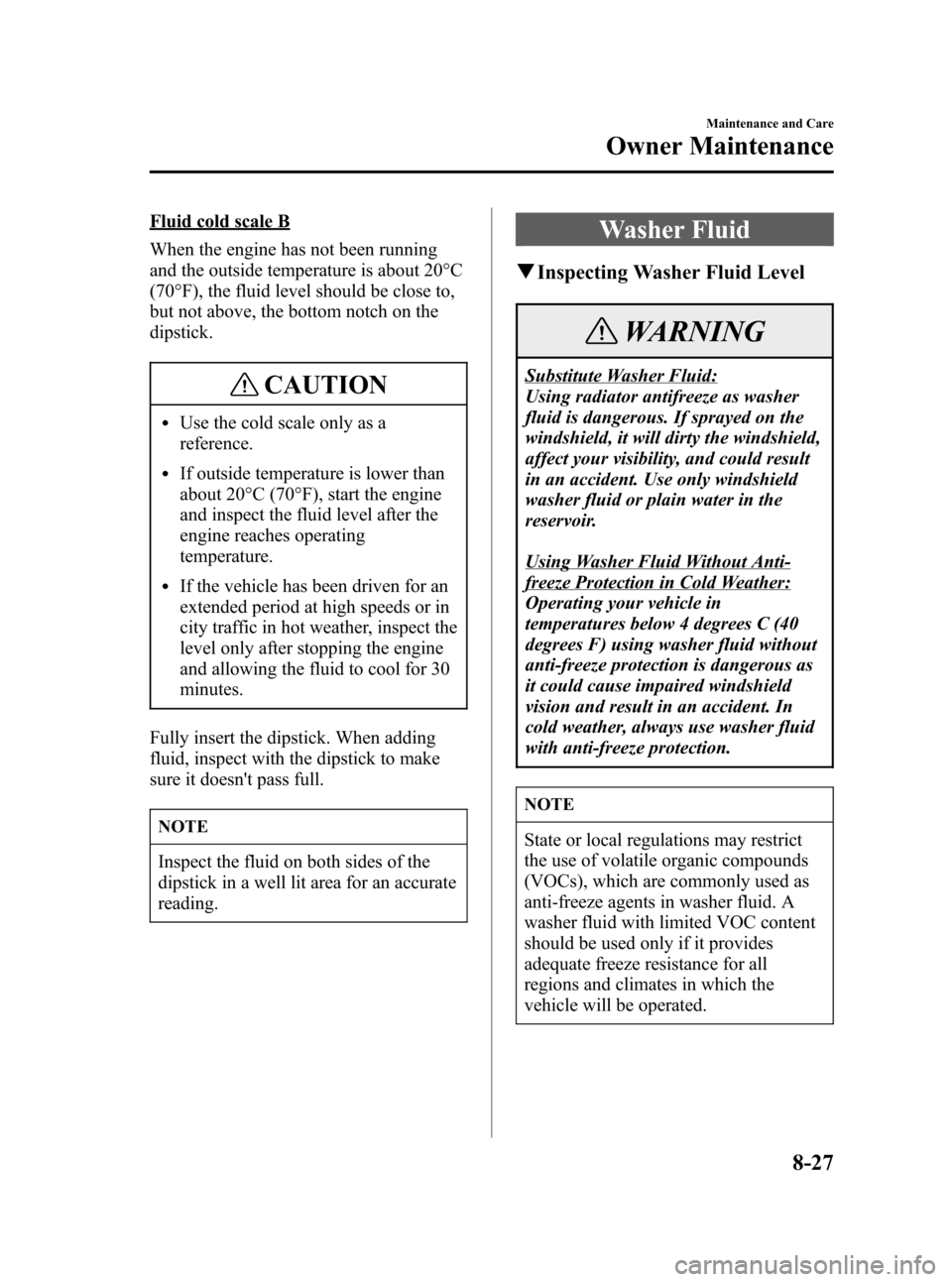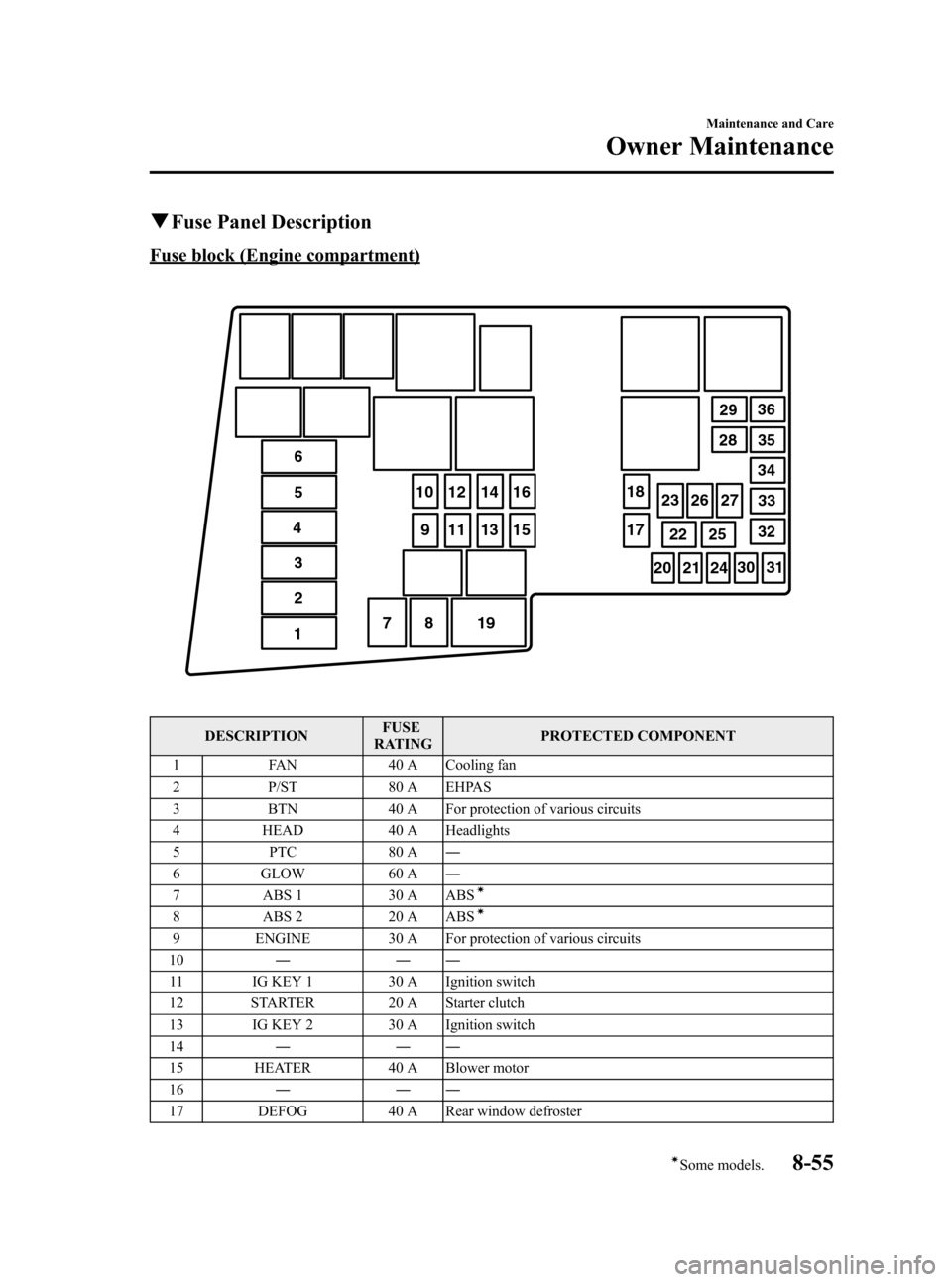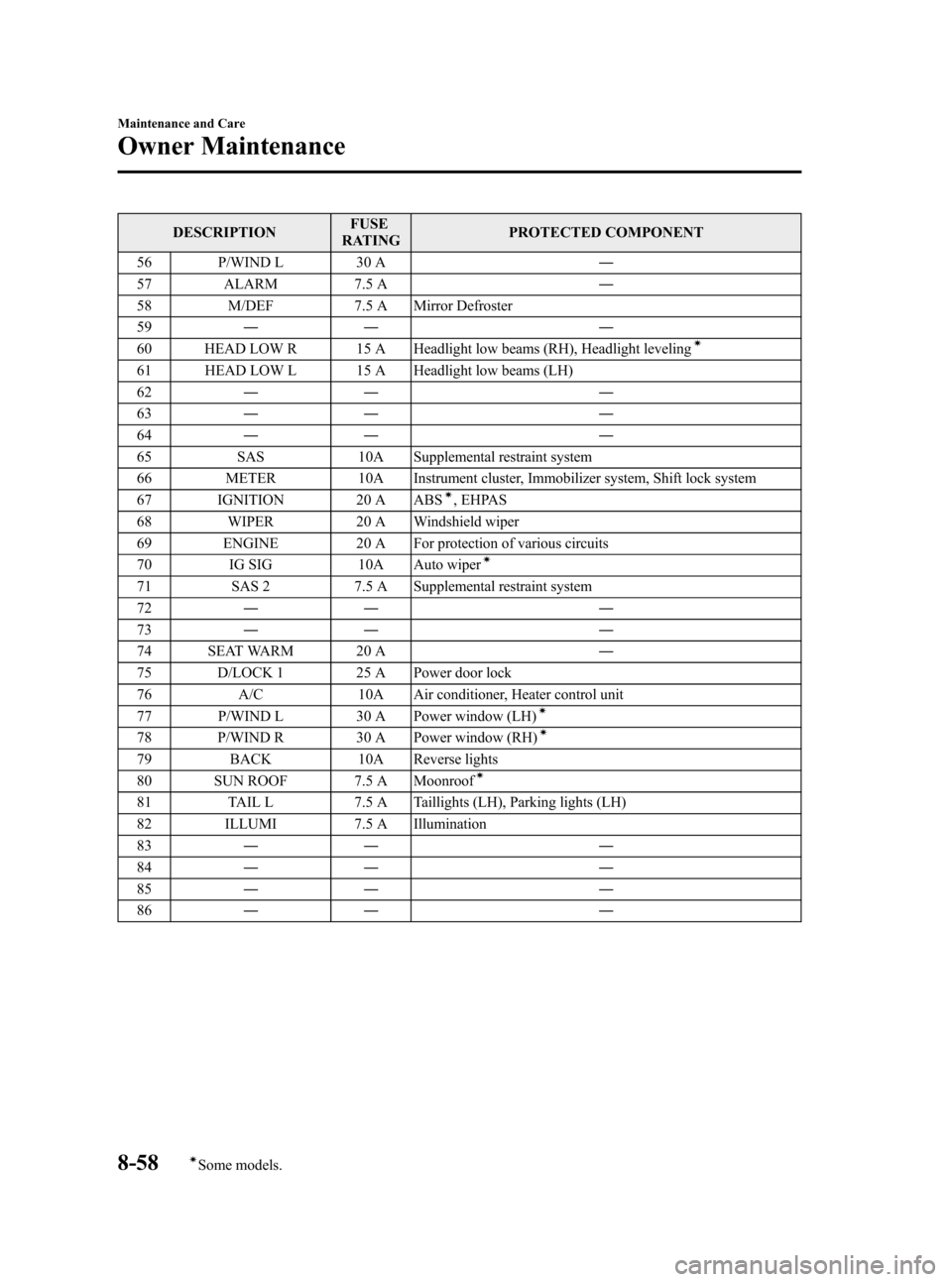engine MAZDA MODEL 3 HATCHBACK 2006 (in English) Manual PDF
[x] Cancel search | Manufacturer: MAZDA, Model Year: 2006, Model line: MODEL 3 HATCHBACK, Model: MAZDA MODEL 3 HATCHBACK 2006Pages: 372, PDF Size: 5.55 MB
Page 271 of 372

Black plate (271,1)
To change coolant
WARNING
Removing the Cooling System Cap:
Removing the cooling system cap
while the engine is running or hot is
dangerous. This might lead to cooling
system and engine damage and could
result in serious injury from escaping
hot coolant or steam. Turn off the
engine and wait until it's cool. Even
then, be very careful when removing
the cap.
Wrap a thick cloth around the cap and
slowly turn it counterclockwise about
two and a half rotations.
Step back while the pressure escapes.
When you're sure all the pressure has
escaped, turn the cap
counterclockwise―still using a cloth
―and remove the cap.
Brake/Clutch Fluid
qInspecting Brake/Clutch Fluid Level
The brakes and clutch draw fluid from the
same reservoir.
Inspect the fluid level in the reservoir
regularly. It should be kept at MAX.
The level normally drops with
accumulated distance, a condition
associated with wear of brake and clutch
linings. If it is excessively low, have the
brake/clutch system inspected by an
Authorized Mazda Dealer.
Maintenance and Care
Owner Maintenance
8-23
Mazda3_8U55-EA-05G_Edition2 Page271
Thursday, June 23 2005 2:56 PM
Form No.8U55-EA-05G
Page 272 of 372

Black plate (272,1)
qAdding Brake/Clutch Fluid
WARNING
Spilled Brake Fluid:
Spilled brake fluid is dangerous. If it
gets in your eyes, they could be
seriously injured. If this happens,
immediately flush your eyes with water
and get medical attention. Brake fluid
spilled on a hot engine could cause a
fire. Be careful not to spill brake fluid
on yourself or on the engine.
Low Brake/Clutch Fluid Levels:
Low brake/clutch fluid levels are
dangerous. Low levels could signal
brake lining wear or a brake system
leak. Your brakes could fail and cause
an accident. If you find a low fluid
level, have the brakes and clutch
inspected.
If the fluid level is low, add fluid until it
reaches MAX.
Before adding fluid, thoroughly clean the
area around the cap.
CAUTION
lBrake and clutch fluid will damage
painted surfaces. If brake or clutch
fluid does get on a painted surface,
wipe it off immediately.
lUsing nonspecified brake and clutch
fluids (page 10-4) will damage the
systems. Mixing different fluids will
also damage them.
If the brake/clutch system frequently
requires new fluid, consult an
Authorized Mazda Dealer.
Power Steering Fluid
qInspecting Power Steering Fluid
Level
CAUTION
To avoid damage to the power steering
pump, don't operate the vehicle for long
periods when the power steering fluid
level is low.
NOTE
Use specified power steering fluid
(page 10-4).
Inspect the fluid level in the reservoir at
each engine oil change with the engine off
and cold. Add fluid if necessary; it does
not require periodic changing.
The level must be kept between MIN and
MAX.
Visually examine the lines and hoses for
leaks and damage.
If new fluid is required frequently, consult
an Authorized Mazda Dealer.
8-24
Maintenance and Care
Owner Maintenance
Mazda3_8U55-EA-05G_Edition2 Page272
Thursday, June 23 2005 2:56 PM
Form No.8U55-EA-05G
Page 273 of 372

Black plate (273,1)
Automatic Transaxle Fluid
(ATF)
qInspecting Automatic Transaxle
Fluid Level
The automatic transaxle fluid level should
be inspected regularly. Measure it as
described below.
2.3-liter engine
CAUTION
lAlways check the automatic
transaxle fluid level according to the
following procedure. If the
procedure is not done correctly, the
automatic transaxle fluid level
cannot be measured accurately
which could lead to automatic
transaxle damage.
lA low fluid level can cause transaxle
slippage. Overfilling can cause
foaming, loss of fluid, and transaxle
malfunction.
lUse only the specified fluid. A non-
specified fluid could result in
transaxle malfunction and failure.
1. Park on a level surface and set the
parking brake firmly.
2. Make sure there is no ATF leakage
from the ATF hose or the housing.
3. Shift the shift lever to the park position
(P), start the engine and warm it up.
CAUTION
Do not shift the shift lever while the
engine is warming up. If the ATF level
is extremely low, the automatic
transaxle could be damaged.
4. While the engine is still idling, pull out
the dipstick and wipe it clean, and then
put it back.
5. Check the ATF level. If there is no ATF
adhering 5 mm from the end of the
dipstick, add ATF.
CAUTION
If there is no ATF adhering to the
dipstick even after the engine has been
warmed up, do not drive the vehicle.
Otherwise, the automatic transaxle
could be damaged.
6. Shift the shift lever to each range and
position, and make sure there is no
abnormality.
7. Drive the vehicle on city roads for 5
km (3.1 mile) or more.
8. Park on a level surface and set the
parking brake firmly.
Maintenance and Care
Owner Maintenance
8-25
Mazda3_8U55-EA-05G_Edition2 Page273
Thursday, June 23 2005 2:56 PM
Form No.8U55-EA-05G
Page 274 of 372

Black plate (274,1)
9. Shift the shift lever to the park position
(P), check the ATF level while the
engine is idling, and make sure that the
ATF level is within the proper level. If
the ATF level is not within the proper
level, add ATF.
The proper fluid level is marked on the
dipstick as follows.
Full
OK
Low
2.0-liter engine
The volume of fluid changes with the
temperature. Fluid must be checked at idle
without driving at normal operating
temperature.
CAUTION
lLow fluid level causes transaxle
slippage. Overfilling can cause
foaming, loss of fluid, and transaxle
malfunction.
lUse specified fluid (page 10-4). A
nonspecified fluid could result in
transaxle malfunction and failure.
1. Park on a level surface and set the
parking brake firmly.
2. Start the engine and depress the brake
pedal.3. Move the shift lever through all ranges
and set it at P.
WARNING
Sudden Vehicle Movement:
Shifting the shift lever without first
depressing the brake pedal is
dangerous. The vehicle could move
suddenly and cause an accident.
Make sure the brake pedal is applied
before shifting the shift lever.
4. With the engine still idling, pull out the
dipstick, wipe it clean, and put it back.
5. Pull it out again.
The proper fluid level is marked on the
dipstick as follows.
Full
A
LowFull
B
Low
Fluid hot scale A
When the vehicle has been driven and the
fluid is at normal operating temperature,
about 65°C (150°F), the level must be
between Full and Low.
8-26
Maintenance and Care
Owner Maintenance
Mazda3_8U55-EA-05G_Edition2 Page274
Thursday, June 23 2005 2:56 PM
Form No.8U55-EA-05G
Page 275 of 372

Black plate (275,1)
Fluid cold scale B
When the engine has not been running
and the outside temperature is about 20°C
(70°F), the fluid level should be close to,
but not above, the bottom notch on the
dipstick.
CAUTION
lUse the cold scale only as a
reference.
lIf outside temperature is lower than
about 20°C (70°F), start the engine
and inspect the fluid level after the
engine reaches operating
temperature.
lIf the vehicle has been driven for an
extended period at high speeds or in
city traffic in hot weather, inspect the
level only after stopping the engine
and allowing the fluid to cool for 30
minutes.
Fully insert the dipstick. When adding
fluid, inspect with the dipstick to make
sure it doesn't pass full.
NOTE
Inspect the fluid on both sides of the
dipstick in a well lit area for an accurate
reading.
Washer Fluid
qInspecting Washer Fluid Level
WARNING
Substitute Washer Fluid:
Using radiator antifreeze as washer
fluid is dangerous. If sprayed on the
windshield, it will dirty the windshield,
affect your visibility, and could result
in an accident. Use only windshield
washer fluid or plain water in the
reservoir.
Using Washer Fluid Without Anti-
freeze Protection in Cold Weather:
Operating your vehicle in
temperatures below 4 degrees C (40
degrees F) using washer fluid without
anti-freeze protection is dangerous as
it could cause impaired windshield
vision and result in an accident. In
cold weather, always use washer fluid
with anti-freeze protection.
NOTE
State or local regulations may restrict
the use of volatile organic compounds
(VOCs), which are commonly used as
anti-freeze agents in washer fluid. A
washer fluid with limited VOC content
should be used only if it provides
adequate freeze resistance for all
regions and climates in which the
vehicle will be operated.
Maintenance and Care
Owner Maintenance
8-27
Mazda3_8U55-EA-05G_Edition2 Page275
Thursday, June 23 2005 2:56 PM
Form No.8U55-EA-05G
Page 276 of 372

Black plate (276,1)
Inspect fluid level in the washer fluid
reservoir; add fluid if necessary.
To inspect the washer fluid level in the
front reservoir, pull off the cap. Then,
holding your thumb over the hole in the
center of the cap, lift it straight up. The
fluid level can be seen from the fluid
column in the pipe. Add fluid if necessary.
Use plain water if washer fluid is
unavailable. But use only washer fluid in
cold weather to prevent it from freezing.
NOTE
Front and rear washer fluid is supplied
from the same reservoir.
Body Lubrication
All moving points of the body, such as
door and hood hinges and locks, should
be lubricated each time the engine oil is
changed. Use a nonfreezing lubricant on
locks during cold weather.
Make sure the hood's secondary latch
keeps the hood from opening when the
primary latch is released.
8-28
Maintenance and Care
Owner Maintenance
Mazda3_8U55-EA-05G_Edition2 Page276
Thursday, June 23 2005 2:56 PM
Form No.8U55-EA-05G
Page 277 of 372

Black plate (277,1)
Air Filter
CAUTION
Don't drive without an air filter. This
could result in excessive engine wear.
This air filter may be cleaned with
compressed air and reused, or replaced,
depending on its condition. Unless it is
very dirty, simply shake it to remove
foreign particles. Each time you inspect it,
wipe inside the air cleaner housing with a
damp cloth.
qReplacing the Air Filter
NOTE
If the vehicle is operated in very dusty
or sandy areas, replace the filter more
often than the recommended intervals.
CAUTION
Use a Mazda genuine air filter. Use of
other filters could damage the airflow
sensor.1. Make sure the ignition switch is turned
off.
2. Remove the battery cover and battery
duct.
Battery duct
Battery cover
3. Unfasten the clamps.
4. Lift off the air filter cover and remove
the filter.
Air filter cover
Air filter
Maintenance and Care
Owner Maintenance
8-29
Mazda3_8U55-EA-05G_Edition2 Page277
Thursday, June 23 2005 2:56 PM
Form No.8U55-EA-05G
Page 301 of 372

Black plate (301,1)
3. Turn the knobs counterclockwise and
lower the fuse block.
4. Locate the position of the suspected
fuse by using the chart inside the fuse
block cover.
5. Pull the fuse straight out with the fuse
puller provided on the inside of the
engine compartment fuse block cover.
6. Inspect it and replace if it's blown.
NormalBlown
7. Push in a new fuse of the same
amperage rating, and make sure it fits
tightly. If it doesn't, have an Authorized
Mazda Dealer install it.
If you have no spare fuses, borrow one
of the same rating from a circuit not
essential to vehicle operation, such as
the MIRROR or CIGAR circuit.
WARNING
Always replace a fuse with one of the
same rating. Otherwise you may
damage the electric system.
Replacing the fuses under the hood
If the headlights or other electrical
components don't work and the fuses in
the cabin are OK, inspect the fuse block
under the hood. If a fuse is blown, it must
be replaced. Follow these steps:
1. Turn off the ignition switch and all
other switches.
Maintenance and Care
Owner Maintenance
8-53
Mazda3_8U55-EA-05G_Edition2 Page301
Thursday, June 23 2005 2:56 PM
Form No.8U55-EA-05G
Page 303 of 372

Black plate (303,1)
qFuse Panel Description
Fuse block (Engine compartment)
12 3 45 6
789 10
11 12
13 14
15 16
17 18
1920 2122 23
24 25 26
27 2829
3031 3233 3435 36
DESCRIPTIONFUSE
RATINGPROTECTED COMPONENT
1 FAN 40 A Cooling fan
2 P/ST 80 A EHPAS
3 BTN 40 A For protection of various circuits
4 HEAD 40 A Headlights
5 PTC 80 A―
6 GLOW 60 A―
7 ABS 1 30 A ABS
í
8 ABS 2 20 A ABSí
9 ENGINE 30 A For protection of various circuits
10―――
11 IG KEY 1 30 A Ignition switch
12 STARTER 20 A Starter clutch
13 IG KEY 2 30 A Ignition switch
14―――
15 HEATER 40 A Blower motor
16―――
17 DEFOG 40 A Rear window defroster
Maintenance and Care
Owner Maintenance
8-55íSome models. Mazda3_8U55-EA-05G_Edition2 Page303
Thursday, June 23 2005 2:56 PM
Form No.8U55-EA-05G
Page 306 of 372

Black plate (306,1)
DESCRIPTIONFUSE
RATINGPROTECTED COMPONENT
56 P/WIND L 30 A―
57 ALARM 7.5 A―
58 M/DEF 7.5 A Mirror Defroster
59―― ―
60 HEAD LOW R 15 A Headlight low beams (RH), Headlight leveling
í
61 HEAD LOW L 15 A Headlight low beams (LH)
62―― ―
63―― ―
64―― ―
65 SAS 10A Supplemental restraint system
66 METER 10A Instrument cluster, Immobilizer system, Shift lock system
67 IGNITION 20 A ABS
í, EHPAS
68 WIPER 20 A Windshield wiper
69 ENGINE 20 A For protection of various circuits
70 IG SIG 10A Auto wiper
í
71 SAS 2 7.5 A Supplemental restraint system
72―― ―
73―― ―
74 SEAT WARM 20 A―
75 D/LOCK 1 25 A Power door lock
76 A/C 10A Air conditioner, Heater control unit
77 P/WIND L 30 A Power window (LH)
í
78 P/WIND R 30 A Power window (RH)í
79 BACK 10A Reverse lights
80 SUN ROOF 7.5 A Moonroofí
81 TAIL L 7.5 A Taillights (LH), Parking lights (LH)
82 ILLUMI 7.5 A Illumination
83―― ―
84―― ―
85―― ―
86―― ―
8-58
Maintenance and Care
íSome models.
Owner Maintenance
Mazda3_8U55-EA-05G_Edition2 Page306
Thursday, June 23 2005 2:56 PM
Form No.8U55-EA-05G